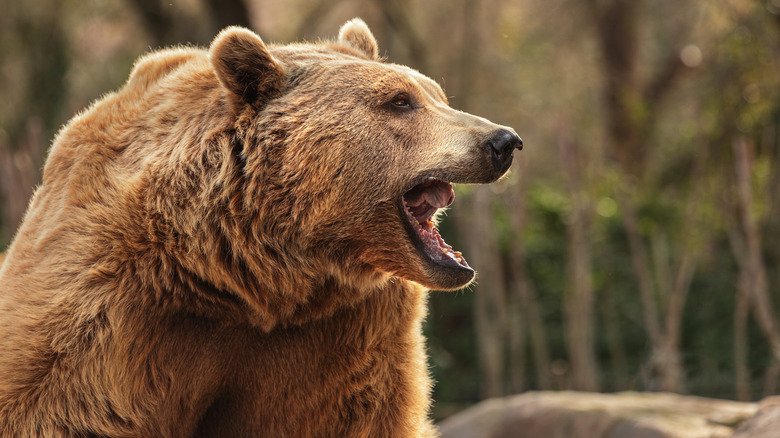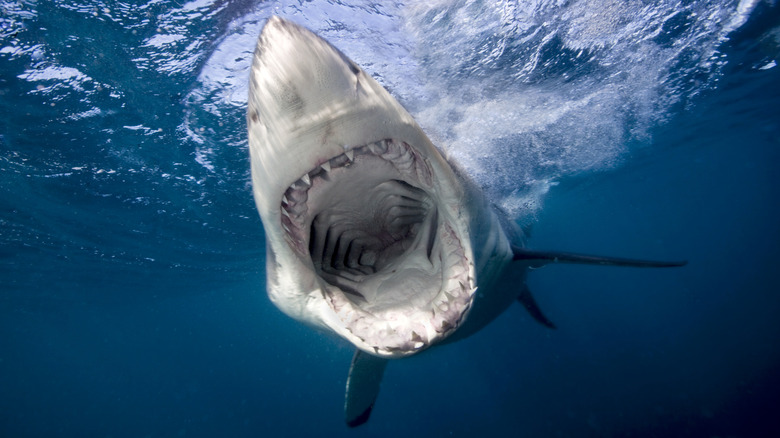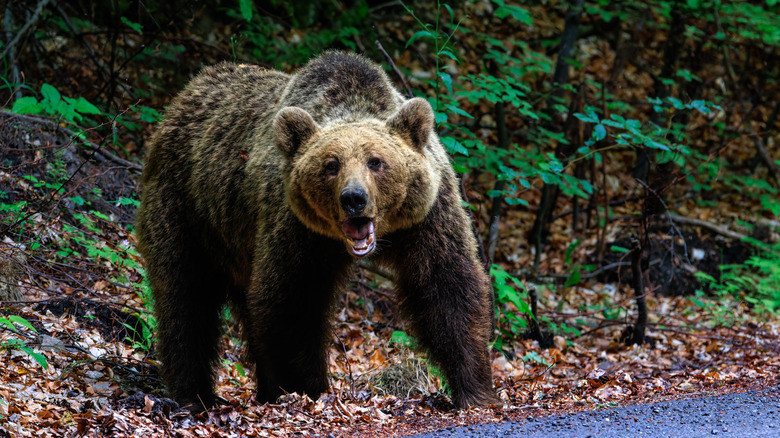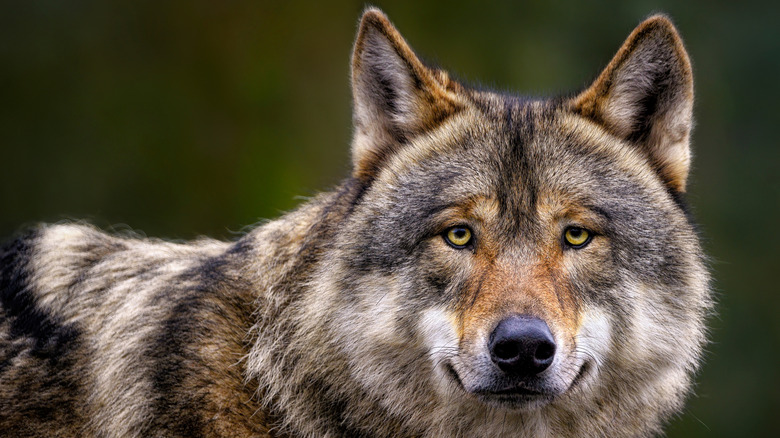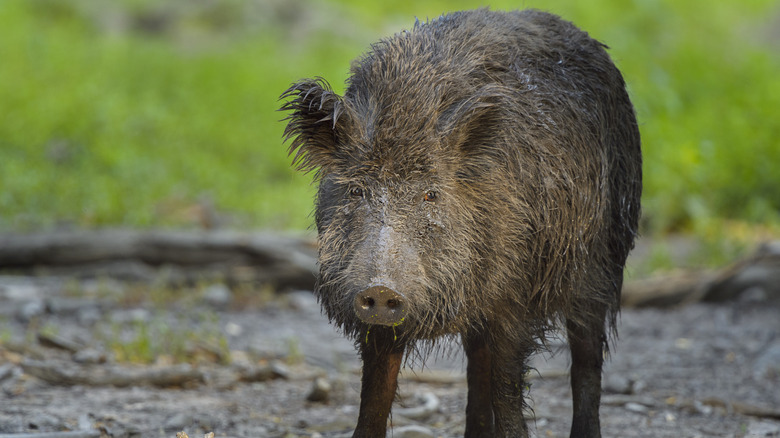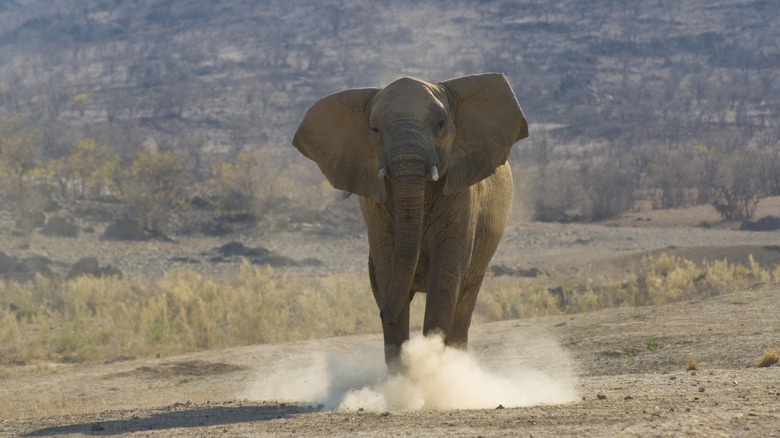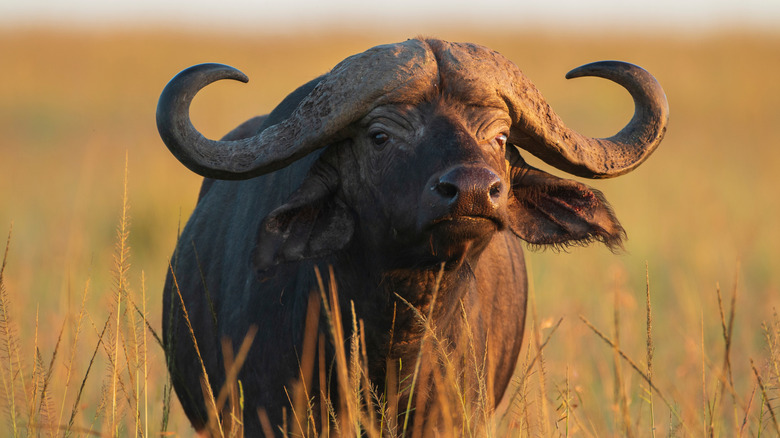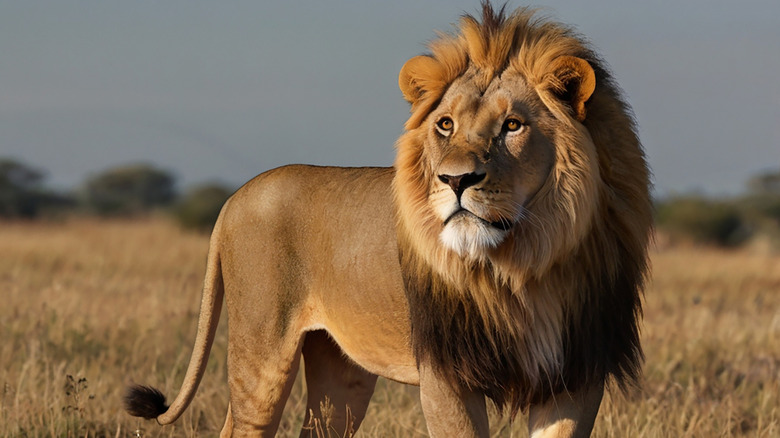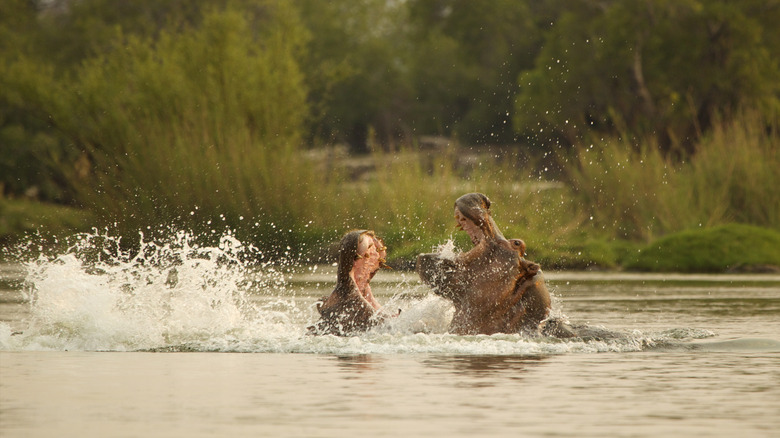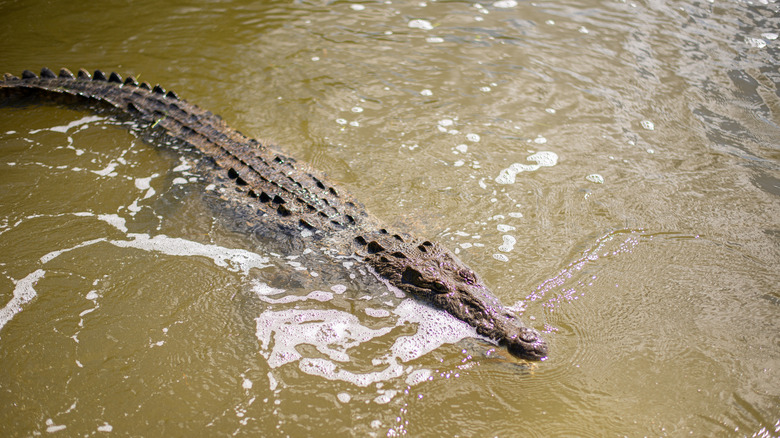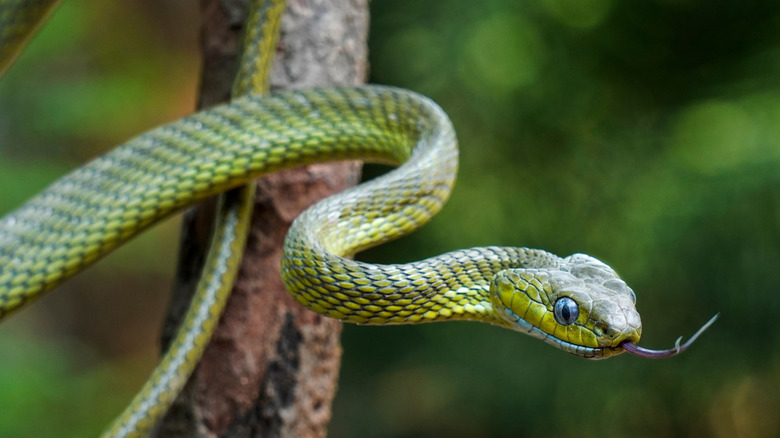Nature's Most Dangerous Wild Animals And How To Survive When They Attack
We may receive a commission on purchases made from links.
When we think of dangerous creatures, it's easy to imagine large predators like lions, bears, or sharks. However, some of the most lethal creatures are far less obvious. For instance, mosquitoes, which kill millions of people each year, are actually the "most deadly" animals on Earth. Parasitic organisms, like tapeworms, also top killer lists. Even dogs, our species' best friend, are responsible for many fatalities each year, though these are primarily due to rabies transmission. While all of these animals are deadly, it's not because they actively attack humans; they are dangerous because of their indirect effects.
This list, however, focuses on animals that will attack you. Whether because of their aggressive tendencies, territorial behaviors, or lethal abilities when threatened or provoked, these creatures pose real risks when we encounter them. Of course, each animal's danger level depends on its habitat and the likelihood of encountering humans. For instance, some animals may cause many deaths globally but are rare in most regions. For that reason, it's hard to rank these animals from least to most dangerous.
Here is a guide of dangerous creatures in the wild and what to do if you find yourself under attack. These animals may not only pose direct physical threats but also present hidden dangers that we might not think twice about — until it's too late. Understanding these creatures and how to survive an encounter with them is key to ensuring your safety when venturing into their territories.
If a shark attacks, always fight back
Sharks are often feared, but the truth is that only a small fraction of shark species are dangerous to humans. Bull sharks, tiger sharks and great white sharks are among the most dangerous types of sharks. These creatures are territorial and have powerful bites that can cause severe damage. While shark attacks are sensationalized in the media, the actual number of fatalities is relatively low, according to a 2021 study in Marine Policy. In 2023, there were only about 14 confirmed shark-related deaths worldwide (via the Florida Museum of Natural History). Still, these attacks can be traumatic, often occurring when sharks mistake humans for prey or feel threatened.
To avoid getting attacked by a shark, avoid swimming during dusk and nighttime, when sharks are active. Refrain from wearing shiny jewelry, which may attract sharks, and do not enter the water if you have an open wound. In the event you do catch a shark's attention and it seems to be heading your way, avoid splashing and sudden movements, which can further provoke it.
If a shark does attack you, the key is to fight back. Sharks are, of course, excellent swimmers and can outswim you easily. Trying to flee will only increase the likelihood that you'll be seen as prey. Instead, focus on defending yourself. Aim for the shark's eyes, gills, or snout, because these areas are the most sensitive and vital to the shark. Use anything you have — your fists, feet, or even a paddle if available — to strike. Once you're able to make distance from the shark, slowly and steadily make your way back to shore, keeping an eye on the shark.
The best protection in bear country is prevention
Bears are among nature's most formidable predators. Compared to some of their cousins, black bears are not viewed as a particularly dangerous type of bear, but it's grizzly and polar bears that are typically more of a threat. Grizzlies are responsible for several fatalities annually, often attacking when they feel threatened — especially if humans approach their cubs or feeding grounds. Polar bears, living in remote Arctic regions, encounter humans less often but are particularly dangerous due to their predatory instincts and lack of fear toward people.
When in bear country, prevention is key. It's generally suggested to make noise to alert them to your presence and scare them away in case they are in the area. Clap, speak loudly, or use bear bells. Always carry bear spray, and store food securely.
If you do encounter a bear, think twice before playing dead. You should first try to identify the type of bear, especially when it comes to grizzly and black bears. Black bears tend to shy away easily, so fighting back is the best thing to do. With grizzlies, rely on the age old adage of playing dead. Even so, some grizzlies may huff, stomp, or bluff charge, which is when they rush at you in an attempt to drive you away but do not make physical contact. Flattened ears and continued approach often indicate an imminent attack. Polar bears rarely bluff; if one follows you, it may be stalking you. Determining if you are in real danger is important before you start to retaliate.
Wolves can attack if they feel threatened
Wolves are highly intelligent predators, and their pack hunting strategy can make them formidable. In regions like North America, Europe, and Asia, wolves are occasionally encountered by humans, usually in rural areas. Most wolves will avoid human interaction, but when they feel threatened or are protecting their pack, they can become aggressive. There are many types of dangerous wolves, but the majority of human attacks by wolves are linked to rabies outbreaks, as rabid wolves are more likely to attack humans.
When in wolf territory, keep food stored securely, as the smell can lure wolves. If you encounter a wolf, do not run. This can trigger a chase, in which case the wolf is likely to outrun you. Instead, make yourself look as intimidating as possible. Maintain eye contact and make yourself appear larger by standing tall, raising your arms, or opening your jacket. Back away very slowly while keeping the wolf in sight — never turn your back.
If the wolf attacks you, use a weapon, stick, rock, backpack, or any nearby object to defend yourself. If no tools are available, fight back with your arms and legs, trying to protect your own neck and face. Target the wolf's sensitive areas like the eyes and snout and make loud noises to make yourself seem more intimidating and deter the animal. Wolves are more likely to retreat when they feel threatened. When you are safe, seek medical attention immediately, especially for potential rabies exposure.
Take care not to surprise a wild boar
You may not think of wild boars immediately when you hear the words "dangerous animal," but these creatures are aggressive and can cause significant harm. If you're adventuring in the Appalachian Mountains, this is definitely one creature to beware of. Wild boars are known to attack humans when they feel endangered, especially in rural areas where human encroachment on their territory is common. They are found in forests, rural areas, and farmlands across the world. Boars are particularly dangerous when they feel cornered or threatened. Their tusks are capable of inflicting deep wounds, and these animals can charge with considerable speed and strength, making it difficult to escape once an attack begins.
If you ever happen upon a wild boar, give it a wide berth and avoid surprising it. Try to back away slowly using calm and deliberate movements. Maintaining a safe distance is crucial, as wild boars can run at around 30 miles per hour. If the boar notices you and charges, your best chance is to climb up to higher ground, such as a sturdy tree or a large rock. Wild boars are not strong climbers, making elevated positions a safer refuge. Higher ground also gives you the advantage of observing the boar's movements and waiting for it to lose interest and leave.
Additionally, avoiding steep downhills during a charge is important. Boars are adept at navigating such terrain and may gain momentum. If climbing isn't an option, use any object you have to shield yourself or distract it. Always aim to stay out of reach of its tusks, which can cause severe injuries.
An elephant gives warning signs before charging
Elephants are among the largest and most powerful animals on the planet. While they are generally docile animals, their power and size mean that even a slight interaction with an angry elephant can have deadly consequences. In fact, they are responsible for hundreds of fatalities each year. The most dangerous encounters typically occur when elephants are found in close proximity to human populations. These incidents often arise from surprise encounters, blocked paths, or mistaken aggression.
When in elephant territory, respect their space, and if you must observe them, do so from a safe distance. Pay attention to local advice and guides who understand elephant behavior. If an elephant flares its ears, trumpets loudly, or mock charges, it's warning you to back off. In these situations, retreat slowly without turning your back and remain calm so that you can present yourself as non-threatening.
If an elephant charges with intent, running in a zigzag pattern can make it harder for them to catch you. Find large obstacles such as boulders or trees to protect you from the sheer size and weight of the animal. Climbing higher can also help as elephants are less adept at step ascents (although, they can certainly knock down a tree). Always remain calm and remember that elephants prefer avoiding humans when possible; it's our actions that often escalate conflicts.
Cape buffalo are known to be temperamental
Cape buffalo are notorious for their unpredictability and strength. The Cape buffalo is part of Africa's "Big Five," a term originally coined by big-game hunters to describe the continent's most challenging animals to hunt. They are not only dangerous but also highly respected for their power. Despite their somewhat docile appearance, they are responsible for more human deaths in the entire continent of Africa than any other animal, with an estimated 200 fatalities annually, per USA Today. These creatures have a powerful build, and when provoked or threatened, they will charge at high speeds with tremendous force. They are particularly dangerous because of their temperamental nature and their ability to turn on a person without warning.
The most common scenarios one would encounter a Cape buffalo include African safari tours, when crossing or working in agricultural areas near their habitats, or during hunting expeditions. If this happens, observe them from a safe distance, ideally using binoculars. Never block their path, especially near watering holes or grazing areas, as this can provoke them into charging.
If a Cape buffalo charges, try to move in a zigzag pattern. This will make it harder for the animal to target you, as they typically rely on a direct line of attack. Finding shelter behind large, immovable objects can also help protect you. Find the biggest and stronger barriers you can, as Cape buffalo have been known to push over obstacles during a charge. Even if the buffalo retreats, remain cautious, as these animals have been said to hold grudges and can circle back even after being initially warded off.
Never run away if you encounter a lion in the wild
Lions are apex predators. Even so, these big cats typically avoid human contact. However, their immense strength, speed, and sharp claws make them a significant threat in certain situations. Most lion attacks occur during surprise encounters or when the animal is defending its territory. So, to reduce the risk of an attack, avoid walking alone, especially at night, in lion-prone areas. These felines are usually most active after dark, and traveling in groups increases the likelihood of spotting warning signs that a lion is nearby. These include paw prints, roars, or carcasses of other animals.
If you encounter a lion, standing your ground is critical, as running can trigger a chase that you will likely lose. Do not turn your back. Instead, make yourself appear larger and make loud noises to discourage the lion from approaching. If the lion does not retreat, back away slowly, while maintaining eye contact.
If a lion charges and makes contact, fight back aggressively. Use anything you can to aim for their sensitive areas, which are on their face. Lions often retreat if their target process is too challenging, so showing resistance may make the animal reconsider its attack — and they prefer easy prey. Remaining assertive can significantly increase your chances of surviving a lion attack.
Hippos are surprisingly fast for their size
Hippos are among the most dangerous animals in Africa, responsible for an estimated 500 deaths annually, according to the BBC's Wildlife Magazine. Despite their herbivorous diet, hippos are territorial and highly aggressive, especially in and around water. They are known to charge at boats or capsize them, and typically attack anything perceived as a threat to their space. On land, hippos are deceptively fast too, capable of running up to 30 kilometers per hour. Their massive size combined with their sharp tusks make them a formidable threat.
To reduce the risk of a hippo encounter, avoid lingering near riverbanks or approaching groups of hippos, especially those with calves. If you see a hippo, try to quickly leave the area, especially if it seems to have noticed you and has its mouth open. Most attacks occur when humans inadvertently come too close to a hippo's territory.
If a hippo charges at you while you're on land, running in a zigzag pattern can be effective, as hippos are less agile when changing direction. Seek shelter behind large objects, as hippos will often lose interest if they encounter obstacles. If you are in the water and a hippo charges, your options are more limited. Submerging yourself to reduce visibility while staying close to the riverbed might help you avoid direct contact because hippos are primarily focused on driving intruders out of their territory rather than actively pursuing them underwater. Hippos have poor underwater vision too, so are less likely to perceive you as a threat if you minimize movement and stay low. This can buy you precious moments to escape or avoid injury.
Crocodiles are opportunistic and know when to ambush
Crocodiles are among the most dangerous reptiles in the world. With a powerful bite force of over 3,000 pounds per square inch and their stealthy hunting tactics, they are responsible for roughly 1,000 fatalities annually (via Wildlife Magazine). These predators are opportunistic and often attack with little warning, making them a significant threat in areas where humans and crocodiles cross paths. This is why folks are often warned to avoid waters known to harbor crocodiles. Heed local warnings and avoid washing or fishing near these waters' edges, as they are ambush predators that can strike with incredible speed.
If attacked, fighting back is crucial. Crocodiles tend to latch onto their prey with their strong jaws, which are designed to hold and crush. Once they bite down, they rarely let go. To force a release, aim for their eyes or nostrils. These are some of the few vulnerable points on their heavily armored bodies. Striking these areas can cause pain or confusion, potentially prompting the crocodile to release its grip. Quick and targeted actions to these areas increase your chances of survival.
If you get pulled into the water, your situation becomes more critical, as they use a strategy called the "death roll" to incapacitate prey. This involves spinning rapidly while holding their victim in their powerful jaws, which can disorient, injure, or drown the target. Underwater, try to hold your breath and focus on targeting the croc's vulnerable points, including the palate at the end of the croc's mouth. Hitting this area might give you a brief moment to escape. Swim to the surface and get back to shore quickly to seek medical attention.
Never attempt to handle venomous snakes
Venomous snakes, including the black mamba, saw-scaled viper, king cobra, and Russell's viper, are some of the most dangerous types of snakes. They are responsible for approximately 100,000 fatalities annually, according to Statista, with many deaths resulting from delayed or unavailable treatment. Their venom can vary in potency and effect, but common outcomes include respiratory failure, severe tissue damage, and in some cases, blood clotting disorders or internal bleeding.
Snakes typically bite as a defensive reaction when they feel threatened or startled. Most bites occur when humans accidentally step on or get too close to a snake, or when attempting to handle or provoke one. To reduce the risk of snake bites, avoid walking through tall grass, dense underbrush, or reaching into hidden spaces like holes or rock crevices. Wearing boots, long pants, and gloves can provide additional protection. Stay vigilant in snake-prone areas, especially at dusk or dawn when many species are most active.
If you do come across a snake, there are some warning signs it may give if it's about to strike. These include hissing, coiling, or rearing up. If you see a snake in a defensive posture or hear a warning hiss, it's a sign to back away slowly. Avoid making sudden movements. If a snake does decide to attack, your best defense is to remain calm and stay aware of the snake's position. You can use a stick or a backpack to create distance from you. Never try to grab or handle the snake. As you move away slowly, try to use a zigzag pattern. Though this may seem counterintuitive since snakes slither in an "S" pattern, they strike with their head, so erratic movements can make it more difficult for them to gauge where you're going.
